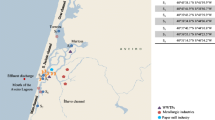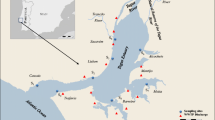Abstract
The Mira River is a Portuguese water body widely known for its wilderness and is advertised as one of the less polluted European rivers. On this presumption, the levels of endocrine-disrupting compounds (EDCs) in Mira waters were never measured. However, because environmentalists have claimed that the Mira could be moderately polluted, a range of 17 EDCs were measured not only at the estuary but also along the river. The targeted EDCs included natural and pharmaceutical oestrogens (17β-oestradiol, oestrone and 17α-ethynylestradiol), industrial/household pollutants (octylphenols, nonylphenols and their monoethoxylates and diethoxylates and bisphenol A), phytoestrogens (formononetin, biochanin A, daidzein, genistein) and the phytosterol sitosterol (SITO). For this propose, waters from six sampling sites were taken every 2 months, over a 1-year period (2011), and analysed by gas chromatography–mass spectrometry. Unexpectedly high levels of oestrogens and of industrial/household pollutants were measured at all sampling sites, including those located inside natural protected areas. Indeed, the annual average sum of EDCs was ≈57 ng/L for oestrogens and ≈1.3 μg/L for industrial/household chemicals. In contrast, the global average levels of phytoestrogens (≈140 ng/L) and of SITO (≈295 ng/L) were lower than those reported worldwide. The EDC concentrations were normalised for ethynylestradiol equivalents (EE2eq). In view of these, the oestrogenic load of the Mira River attained ≈47 ng/L EE2eq. In addition, phosphates were above legal limits at both spring and summer (>1 mg/L). Overall, data show EDCs at toxicant relevant levels in the Mira and stress the need to monitor rivers that are allegedly less polluted.







Similar content being viewed by others
References
Agapito, D., Mendes, J., & do Valle, P. O. (2012). The rural village as an open door to nature-based tourism in Portugal: the Aldeia da Pedralva case. Tourism, 60(3), 325–338.
Benassayag, C., Perrot-Applanat, M., & Ferre, F. (2002). Phytoestrogens as modulators of steroid action in target cells. Journal of Chromatography B, 777(1–2), 233–248. doi:10.1016/S1570-0232(02)00340-9.
Bettencourt, A.M., Bricker, S.B., Ferreira, J.G., Franco, A., Marques, J.C., Melo, J.J., et al. (2003). Typology and reference conditions for Portuguese transitional and coastal waters. Development of guidelines for the application of the European Union Water Framework Directive. INAG – Instituto da Água, 1–119.
Caldwell, D. J., Mastrocco, F., Anderson, P. D., Lange, R., & Sumpter, J. P. (2012). Predicted-no-effect concentrations for the steroid estrogens estrone, 17beta-estradiol, estriol, and 17alpha-ethinylestradiol. Environmental Toxicology and Chemistry, 31(6), 1396–1406.
Chainho, P., Chaves, M. L., Costa, J. L., Costa, M. J., & Dauer, D. M. (2008). Use of multimetric indices to classify estuaries with different hydromorphological characteristics and different levels of human pressure. Marine Pollution Bulletin, 56(6), 1128–1137. doi:10.1016/j.marpolbul.2008.03.018.
Clotfelter, E. D., & Rodriguez, A. C. (2006). Behavioral changes in fish exposed to phytoestrogens. Environmental Pollution, 144(3), 833–839. doi:10.1016/j.envpol.2006.02.007.
Coldham, N. G., Dave, M., Sivapathasundaram, S., McDonnell, D. P., Connor, C., & Sauer, M. J. (1997). Evaluation of a recombinant yeast cell estrogen screening assay. Environmental Health Perspectives, 105, 734–742.
Directive. (2000). Directive 2000/60/EC of the European Parliament and of the council. Official Journal of the European Communities.
Directive. (2003). Directive 2003/53/EC. Book of the amending for the 26th time Council Directive 76/769/EEC relating to restrictions on the marketing and use of certain dangerous substances and preparations (nonylphenol, nonylphenol ethoxylate and cement) L178/24-L178/27: Official Journal of the European Union.
Ferreira, J.G., Simas, T., Nobre, A., Silva, M.C., Shifferegger, K., & Lencart-Silva, J. (2003). Identification of sensitive areas and vulnerable zones in transitional and coastal Portuguese systems. Application of the United States National estuarine eutrophication assessment to the Minho, Lima, Douro, Ria de Aveiro, Mondego, Tagus, Sado, Mira, Ria Formosa and Guadiana systems. In I. a. IMAR (Ed.).
FSA. (2003). Food Standards Agency, working group on phytoestrogens and health of the committee of toxicology of chemicals in food, consumer products and the environment: phytoestrogens and health. In C. Copyright (Ed.), COT Report.
Hammer, Ø., Harper, D. A. T., & Ryan, P. D. (2001). PAST: paleontological statistics software package for education and data analysis. Palaeontologia Electronica, 4, 1–9.
Hoerger, C. C., Wettstein, F. E., Hungerbuehler, K., & Bucheli, T. D. (2009). Occurrence and origin of estrogenic isoflavones in Swiss river waters. Environmental Science & Technology, 43(16), 6151–6157. doi:10.1021/es901034u.
Kelly, M. M., & Arnold, W. A. (2012). Direct and indirect photolysis of the phytoestrogens genistein and daidzein. Environmental Science & Technology, 46(10), 5396–5403. doi:10.1021/es300041f.
Kostich, M., Flick, R., & Martinson, J. (2013). Comparing predicted estrogen concentrations with measurements in US waters. Environmental Pollution, 178(0), 271–277. doi:10.1016/j.envpol.2013.03.024.
Leusch, F. D. L., & MacLatchy, D. L. (2003). In vivo implants of β-sitosterol cause reductions of reactive cholesterol pools in mitochondria isolated from gonads of male goldfish (Carassius auratus). General and Comparative Endocrinology, 134(3), 255–263. doi:10.1016/S0016-6480(03)00265-X.
Micić, V., & Hofmann, T. (2009). Occurrence and behaviour of selected hydrophobic alkylphenolic compounds in the Danube River. Environmental Pollution, 157(10), 2759–2768. doi:10.1016/j.envpol.2009.04.028.
Mills, L. J., & Chichester, C. (2005). Review of evidence: are endocrine-disrupting chemicals in the aquatic environment impacting fish populations? Science of The Total Environment, 343(1–3), 1–34. doi:10.1016/j.scitotenv.2004.12.070.
Pojana, G., Gomiero, A., Jonkers, N., & Marcomini, A. (2007). Natural and synthetic endocrine disrupting compounds (EDCs) in water, sediment and biota of a coastal lagoon. Environment International, 33(7), 929–936. doi:10.1016/j.envint.2007.05.003.
Público. (2011). Nova estação para tratar esgotos em Milfontes. In: http://www.publico.pt/j374643.
Rocha, M. J., Cruzeiro, C., Reis, M., Rocha, E., & Pardal, M. (2013a). Determination of seventeen endocrine disruptor compounds and their spatial and seasonal distribution in Ria Formosa Lagoon (Portugal). Environmental Monitoring and Assessment, 185(10), 8215–8226. doi:10.1007/s10661-013-3168-5.
Rocha, M. J., Cruzeiro, C., Reis, M., Rocha, E., & Pardal, M. A. (2013b). Determination of 17 endocrine disruptor compounds and their spatial and seasonal distribution in the Sado River Estuary (Portugal). Toxicological & Environmental Chemistry, 95(2), 237–253. doi:10.1080/02772248.2012.758730.
Rocha, M. J., Cruzeiro, C., & Rocha, E. (2013c). Development and validation of a GC-MS method for the evaluation of 17 endocrine disruptor compounds, including phytoestrogens and sitosterol, in coastal waters—their spatial and seasonal levels in Porto costal region (Portugal). [Article]. Journal of Water and Health, 11(2), 281–296. doi:10.2166/wh.2013.021.
Rocha, M., Cruzeiro, C., Peixoto, C., & Rocha, E. (2014a). Annual fluctuations of endocrine-disrupting compounds at the lower end of the Lima River, Portugal, and in adjacent coastal waters. Archives of Environmental Contamination and Toxicology, 67(3), 389–401. doi:10.1007/s00244-014-0063-1.
Rocha, M. J., Cruzeiro, C., Peixoto, C., & Rocha, E. (2014b). Annual fluctuations of endocrine-disrupting compounds at the lower end of the Lima River, Portugal, and in adjacent coastal waters. Archives of Environmental Contamination and Toxicology, 67(3), 389–401. doi:10.1007/s00244-014-0063-1.
Rocha, M. J., Cruzeiro, C., Reis, M., Pardal, M. A., & Rocha, E. (2014c). Spatial and seasonal distribution of 17 endocrine disruptor compounds in an urban estuary (Mondego River, Portugal): evaluation of the estrogenic load of the area. Environmental Monitoring and Assessment, 186(6), 3337–3350. doi:10.1007/s10661-014-3621-0.
Rodriguez-Mozaz, S., López de Alda, M. J., & Barceló, D. (2004). Monitoring of estrogens, pesticides and bisphenol A in natural waters and drinking water treatment plants by solid-phase extraction–liquid chromatography–mass spectrometry. Journal of Chromatography A, 1045(1–2), 85–92. doi:10.1016/j.chroma.2004.06.040.
Safe, S. H. (2000). Endocrine disruptors and human health—is there a problem? An update. Environmental Health Perspectives, 108(6), 487–493.
Sharma, V. K., Anquandah, G. A. K., Yngard, R. A., Kim, H., Fekete, J., Bouzek, K., et al. (2009). Nonylphenol, octylphenol, and bisphenol-A in the aquatic environment: a review on occurrence, fate, and treatment. Journal of Environmental Science and Health, Part A, 44(5), 423–442. doi:10.1080/10934520902719704.
Sharpe, R. L., Woodhouse, A., Moon, T. W., Trudeau, V. L., & MacLatchy, D. L. (2007). β-Sitosterol and 17β-estradiol alter gonadal steroidogenic acute regulatory protein (StAR) expression in goldfish, Carassius auratus. General and Comparative Endocrinology, 151(1), 34–41. doi:10.1016/j.ygcen.2006.11.005.
Sodré, F. F., Pescara, I. C., Montagner, C. C., & Jardim, W. F. (2010). Assessing selected estrogens and xenoestrogens in Brazilian surface waters by liquid chromatography–tandem mass spectrometry. Microchemical Journal, 96(1), 92–98. doi:10.1016/j.microc.2010.02.012.
Urbatzka, R., Rocha, E., Reis, B., Cruzeiro, C., Monteiro, R. A. F., & Rocha, M. J. (2012). Effects of ethinylestradiol and of an environmentally relevant mixture of xenoestrogens on steroidogenic gene expression and specific transcription factors in zebrafish. Environmental Pollution, 164, 28–35. doi:10.1016/j.envpol.2012.01.018.
USEPA. (1996). Environmental indicators of water quality in the United States (US EPA 841-R-96-02). In O. o. w. (4503F) (Ed.). Washington, D.C.: US Government Printing Office.
WFD. (2013). Directive 2013/39/EU of the European Parliament and of the Council of 12 August 2013 amending Directives 2000/60/EC and 2008/105/EC as regards priority substances in the field of water policy. Official Journal of the European Union.
WHO (2011). Guidelines for drinking-water quality - Nitrate and nitrite in drinking-water. In B. d. f. development (Ed.): W. H. Organization.
Ying, G.-G., Kookana, R. S., & Ru, Y.-J. (2002a). Occurrence and fate of hormone steroids in the environment. Environment International, 28(6), 545–551. doi:10.1016/S0160-4120(02)00075-2.
Ying, G.-G., Williams, B., & Kookana, R. (2002b). Environmental fate of alkylphenols and alkylphenol ethoxylates—a review. Environment International, 28(3), 215–226. doi:10.1016/S0160-4120(02)00017-X.
Yu, Y., Huang, Q., Wang, Z., Zhang, K., Tang, C., Cui, J., et al. (2011). Occurrence and behavior of pharmaceuticals, steroid hormones, and endocrine-disrupting personal care products in wastewater and the recipient river water of the Pearl River Delta, South China. Journal of Environmental Monitoring, 13(4), 871–878. doi:10.1039/c0em00602e.
Zhao, J. L., Ying, G. G., Chen, F., Liu, Y. S., Wang, L., Yang, B., et al. (2011). Estrogenic activity profiles and risks in surface waters and sediments of the Pearl River system in South China assessed by chemical analysis and in vitro bioassay. Journal of Environmental Monitoring, 13(4), 813–821.
Zoller, U. (2006). Estuarine and coastal zone marine pollution by the nonionic alkylphenol ethoxylates endocrine disrupters: is there a potential ecotoxicological problem? Environment International, 32(2), 269–272. doi:10.1016/j.envint.2005.08.023.
Zoller, U., Plaut, I., & Hushan, M. (2004). The case of the nonionic alkylphenol ethoxylates in the Mediterranean Sea region: is there a problem? Water Science and Technology: a Journal of the International Association on Water Pollution Research, 50(5), 79–84.
Acknowledgments
This study was partially supported by the European Regional Development Fund (ERDF), through the Operational Competitiveness Program (COMPETE), and by Portuguese funds, through the Foundation for Science and Technology (FCT), via projects PTDC/MAR/70436/2006 and PEst-C/MAR/LA0015/2013.
Author information
Authors and Affiliations
Corresponding author
Electronic supplementary material
Below is the link to the electronic supplementary material.
Table A
Figures referring to intra and inter-day precision, accuracy and recovery data for all EDCs spiked at three different levels of concentration (low, medium and high) in artificial coastal water (Rocha et al. 2013c). (DOCX 23 kb)
Table B
Analytical characteristics of the optimized GC-MS method (Rocha et al. 2013c): calibration equations, coefficients of determination (r2), method detection limit (MDL), time of retention (tR), and quantification / diagnostic ions used in GC-MS analysis. Inside brackets is referred to the relative abundance of ions (m/z) for each target EDC. (DOCX 17 kb)
Rights and permissions
About this article
Cite this article
Rocha, M.J., Cruzeiro, C., Reis, M. et al. Pollution by oestrogenic endocrine disruptors and β-sitosterol in a south-western European river (Mira, Portugal). Environ Monit Assess 188, 240 (2016). https://doi.org/10.1007/s10661-016-5236-0
Received:
Accepted:
Published:
DOI: https://doi.org/10.1007/s10661-016-5236-0




